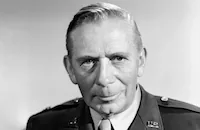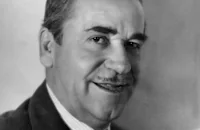Salute to the Marines

Brief Synopsis
Cast & Crew
S. Sylvan Simon
Wallace Beery
Fay Bainter
Reginald Owen
Keye Luke
Ray Collins
Film Details
Technical Specs

Synopsis
In 1943, at a San Diego Marine base, commanding officer Colonel Mason addresses the graduating marines and relates a story that occurred just three years before: William Bailey, a tough, but dedicated sergeant major stationed in the Philippines, is the friend and trainer of "Flashy" Logaz, a former lightweight world champion who hopes to regain his title. One day, Mason sends for Bailey and introduces him to a member of the Philippine government, which is due to receive its independence in 1945. Mason then tells Bailey that he is to train Philippine civilians. Bailey, who is soon to retire, hates the thought of training civilians, and wants instead to have the opportunity to see action. Bailey is at first frustrated by new recruits who do not understand the rationale of military discipline and prefer traditional bolas to bayonets. A month later, however, the well-trained recruits have earned Bailey's respect. When Bailey hears that his battalion is being sent to Shanghai, he rushes to Mason, who had promised him a transfer if the unit was going to see action, but the colonel says that neither of them will be going because of their age. That night, Bailey is arrested by M.P.s after he goes on a binge and, with Flashy's help, gets into a fight with some merchant marines. After Bailey's wife Jennie and daughter Helen visit him in the brig, Helen successfully pleads with Mason to have her father discharged early. Bailey then goes to live with his family in the nearby town of Balanga, in which many American and British expatriots reside. Bailey is uncomfortable with civilian life and has a hard time adjusting, so he starts to train the village children as he continues to coach Flashy. The village mothers do not want their children doing military training, and Jennie, who neither believes in war nor understands his frustration, is disgusted. When some Japanese merchant marines arrive with supplies, Casper, the storeowner, tells the suspicious Bailey that the men are "peace-loving," but Bailey and Flashy think their ship is too well equipped. One afternoon, marines Rufus Cleveland and Randall James, rivals for Helen's affections, arrive at Balanga. When Helen accepts Rufe's proposal, Jennie receives the news with sadness, revealing to her husband that marriage to a marine is difficult. As Christmas approaches, Jennie and Bailey have become closer, and Jennie is hopeful that peace talks in Washington will go well. One Sunday morning, however, Rufe, who is flying, encounters Japanese planes and gets the message that Pearl Harbor has been bombed. At the same time, villagers hear the planes as they attend church and soon bombs begin to fall. After the attack, Casper urges the villagers to fight against American forces, but Bailey comes into the crowd carrying the body of a dead child and reveals Casper for what he is, a Nazi who has secretly been aiding the Japanese. He then rallies the villagers by saying that Filipinos are just as American as he, and kills Casper with his bare hands. Just as Bailey starts to organize the villagers, Rufe arrives. He wants to help, but Bailey insists that he fly to headquarters to warn them, taking the women and children with him. A short time later, sailors from the Japanese ship don their military uniforms and invade the village. Bailey now directs the battle and leads the way toward a bridge that is critical to the Japanese. As the battle rages, Bailey proudly sees that Jennie has stayed behind to help the wounded. Soon, increasing numbers of Japanese foot soldiers, tanks and planes attack as the American reinforcements trudge toward Bailey and his men. After a large loss of life, the Americans successfully dynamite the bridge and rout the Japanese. Bailey then tells the men to take to the hills and fight the way they know best because the Japanese are going to try to take over the islands. After sadly bidding Flashy and the other Filipinos goodbye, Bailey and Jennie embrace as the Japanese bombing resumes. Back in San Diego, Helen, who is now a member of the women's reserve of the Marine Corps, accepts her father's posthumous Congressional Medal of Honor and says goodbye to Rufe as he leaves for a new post.

Director

S. Sylvan Simon
Cast

Wallace Beery

Fay Bainter

Reginald Owen

Keye Luke

Ray Collins

Marilyn Maxwell

William Lundigan

Donald Curtis

Noah Beery Sr.
Dick Curtis
Russell Gleason

Rose Hobart

James Davis
Mark Daniels
Leonard Strong
Harry Hayden

Fritz Leiber
Charles Trowbridge
Jenny Mac
Harold Debecker
Mary Field

Frank Ferguson
William Bishop
Arthur Space

Wally Cassell
Billy Nelson
Carl Saxe
Escamillo Fernandez
Dick Winslow
Byron Shores
Dewey Robinson
Chick Collins
William Haade
William Tannen
Boots Brown
Myron Healey
Edward Fielding
Archie Got
Paul Fung
Kam Tong
Eddie Lee
Frank Tang
Kim Wong
Angel Cruz
Chester Gan
Wing Foo
Billy Cruz
Tom Yuen

Addison Richards

Don Taylor
Hugh Beaumont

Dave O'brien
Jimmy Garwood
Phil Schumacher
Bill Hickman

Harry Warren
Bernie Sell

Bobby Blake
Crew
Robert D. Andrews
Major Nixon L. Ballard
Glen Barner
George Bruce
John W. Considine Jr.
Jack Dawn
Norman Elzer
Cedric Gibbons
Arnold Gillespie
W. Howard Greene
Lennie Hayton
Howard Horton
Horace Hough
Irene
Henry Jaffa
Natalie Kalmus
Gil Kurland
Jay Marchant
Paul Marquardt
Lieut. Col. Andrew Montgomery
Warren Newcombe
Jacques Offenbach
Lieut. Col. G. Mcguire Pierce United States Marine Corps
Stan Rogers
Wells Root
Charles Schoenbaum
Douglas Shearer
Shoup
Fredrick Y. Smith
Lynden Sparhawk
Edwin B. Willis

Film Details
Technical Specs

Articles
Salute to the Marines
Filmed on the heels of the attack on Pearl Harbor, Salute to the Marines pulsates with the patriotism of its era, which also includes the expected cultural stereotypes and derogatory depiction of the enemy. But the film can also be viewed as an allegory about the U.S. entry into WWII. Bailey had never seen combat, until his home was attacked, and he stepped up to do his duty. Likewise, Bailey's daughter Helen (Marilyn Maxwell) begins the movie as a pacifist, more interested in dating than patriotism. And not to give away the ending, but a tragic event makes Helen understand the sacrifice of war, just as it took Pearl Harbor to motivate America to enter World War II.
From Sergeant Bailey on down, Salute to the Marines fills the ranks with familiar faces. Wallace Beery takes the lead, with a successful Hollywood career that had already spanned over 20 years by the time he appeared in this movie. Beery got his start in show biz at the age of 16 when he joined the circus. He began as an assistant to the elephant trainer but left Ringling Bros. two years later after a leopard clawed his arm. From there, Beery hit the Big Apple, performing in variety shows and Broadway musicals. As most performers of that time, Beery eventually ended up in Hollywood to try his hand in silent pictures. His break came with a rather interesting part, Sweedie the Swedish maid in a series of shorts for Essanay Studios. During this period, Beery also met and married actress Gloria Swanson, with whom he starred in a series of Mack Sennett comedies. Unfortunately, however, the marriage was short lived, lasting only a few years from 1916-18. But Beery's luck in the silents was better. He starred in numerous hits like The Last of the Mohicans (1920), Robin Hood (1922) and The Lost World(1925). In 1931, Beery won the Best Actor Oscar for The Champ and proved that despite his surly looks and rough voice, he could play the hero, as he later did in MGM successes like Hell Divers (1931) and Viva Villa! (1934).
Of course Wallace Beery wasn't the only one in his family in the business. His half-brother Noah Beery, Sr. also had quite a long Hollywood career, with movies likeThe Mark of Zorro (1920), Beau Geste (1926) and Riders of the Purple Sage (1931). Likewise, nephew Noah Beery, Jr. made a name for himself in movies like Of Mice and Men and Only Angels Have Wings (both 1939). Brother Noah also appears in Salute to the Marines as a Marine Adjutant.
Oscar winner Fay Bainter starred in the supporting role of Sergeant Bailey's wife. The actress made Oscar history in 1938, when she was nominated for two Academy Awards in different categories. First, Bainter received a Best Actress nod for her part in White Banners (1938). Then, she was nominated in the Best Supporting Actress category (it was her second nomination in this category) for her role as Bette Davis' aunt in Jezebel (1938). Bainter would take home the Best Supporting Actress statuette for Jezebel.
Future blonde bombshell Marilyn Maxwell also received her first substantial part in Salute to the Marines. A relative newcomer to Hollywood, Maxwell's previous parts had included small roles in Stand By For Action, with Judy Garland in Presenting Lily Mars and in the Red Skelton, Lucille Ball, Gene Kelly vehicle Du Barry Was a Lady all in 1943. But Maxwell really shines in Salute to the Marines as the Marine's idealistic daughter who comes to symbolize young America.
Two other minor players in Salute to the Marines became more famous in later years. Future TV father Hugh Beaumont appears uncredited in the film as a Sergeant. Though Beaumont had a mildly successful movies career, he's probably best remembered as Ward Cleaver on Leave It To Beaver. Recent newsmaker Robert Blake also turns up in Salute to the Marines. Credited as Bobby Blake, the ten-year-old plays a character named Little Beaver.
Producer: John W. Considine, Jr.
Director: S. Sylvan Simon
Screenplay: George Bruce, Wells Root, based on the novel by Robert D. Andrews
Art Direction: Cedric Gibbons, Stan Rogers
Cinematography: W. Howard Greene, Charles E. Schoenbaum
Film Editing: Fredrick Y. Smith
Special Effects: A. Arnold Gillespie, Warren Newcombe
Original Music: Lennie Hayton
Cast: Wallace Beery (Sgt. Maj. William Bailey), Reginald Owen (Mr. Caspar), William Lundigan (Rufus Cleveland), Keye Luke ('Flashy' Logaz), Fay Bainter (Jennie Bailey), Marilyn Maxwell (Helen Bailey), Noah Beery (Adjutant), Ray Collins (Colonel Mason).
C-102m.
by Stephanie Thames

Salute to the Marines
Quotes
Trivia
Notes
An onscreen written prologue salutes the United States Marines and names a number of famous battles in which the marines participated, from Tripoli to Guadalcanal. According to a pre-production Hollywood Reporter news item, screenwriter George Bruce wrote a variation of his famous 1919 poem "I Saw Him at Chateau Thiery" to be included in the film under the title "I Saw Him at Wake Island," but the poem was not in the picture. According to various Hollywood Reporter news items, Marjorie Main, Van Johnson and Lewis Stone were originally cast in the film, and Hayes Goetz was supposed to be the assistant director. Actor Richard Quine was initially cast as "Rufus Cleveland," but was replaced by William Lundigan when he was drafted. Guillermo Lopez, a former student of actor Donald Curtis (who had been a university professor prior to becoming an actor), was also cast in the film, but his appearance has not been confirmed. A October 26, 1942 news item noted that Susan Simon, the four-year-old daughter of director S. Sylvan Simon, was to make her acting debut in the film, but her appearance has not been confirmed. News items also indicate that portions of the film were shot on location at a Marine base in San Diego, CA and in Oroville, CA. The Feather River Gateway Bridge, four miles from Oroville, was used for the film's battle sequence. Additional locations were "scouted" in North Carolina and elsewhere, but the film was apparently shot only in California. Wallace Beery, Fay Bainter and Keye Luke reprised their roles for a Lux Radio Theatre broadcast on November 8, 1943. Noah Beery, Sr., who portrayed an adjutant in the picture, took over the role of "Colonel Mason" for the radio program.















